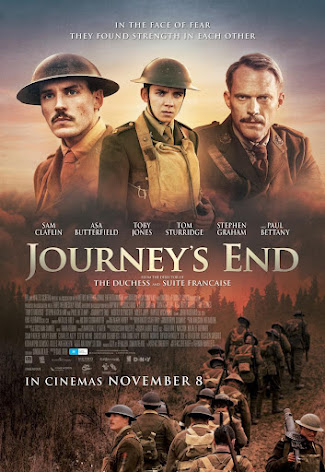Bunker blues
Monday, July 18, 2022
It’s challenging to assess a movie about major combat—especially one representing WW I or II—and not deduce its primary message as “war is hell.” That’s because the vast majority of pictures portraying armed conflict and the experiences of its military members are violent, downbeat, disturbing affairs designed to jolt us out of any semblance of spectator stupor and impart a cautionary tale of sorts about the physical and psychological casualties of battle. Journey’s End, a 2017 production directed by Saul Dibb and based on the famous play by R.C. Sherriff, falls within that category, certainly. But it also resonates as a different spin on the war drama subgenre in how it showcases the insular interpersonal dynamics within a confined setting, serving as a rare treatise on what happens between the bomb blasts and between the ears of officers and grunts struggling with PTSD. We gave this film the CineVerse treatment last week and offer the following postulations (to listen to a recording of our group discussion, click here).
What elements did you find unanticipated, surprising, impactful, or unusual about Journey’s End?
- There have been numerous films depicting World War I combat, trench warfare, and the plight of soldiers during that conflict. However, this story provides a rare glimpse inside the world just adjacent to the trenches: the underground bunkers where the officers reside and make vital decisions that will impact the infantry. We are intimately shown their living conditions, diets, and social undercurrents.
- Despite being a part of a massive and extensive western front that stretches across France, the story and its visuals are claustrophobic, confining, dank, dark, and oppressive. To capture an authentic look and enhance the restrictive setting, the filmmakers shot all interior scenes via candlelight and employed Steadicam and handheld cameras for intimate mobility around the actors.
- Unlike other films that dramatize an especially important battle or turning point in a war, like The Longest Day, Dunkirk, or Saving Private Ryan, this picture focuses on a relatively pointless week in the lives of a company who has the misfortune of having to serve their six-days-per-month rotation on the front lines, just as the long-anticipated German offensive is about to strike. The building dread, foreboding vibe, and lack of advancing action are what’s important here.
- Also, this movie presents minimal action or combat. It’s more of a character study that centers on revealing dialogue and relationship dynamics between officers.
Major themes
- The futility and senselessness of war. The mission that Stanhope’s company is given to storm the enemy’s trench and capture a German soldier won’t make a difference in the war and will result in meaningless deaths. By the end of the story, everyone from Stanhope’s unit will be dead. Yet, the closing titles indicate that nothing was gained from their efforts: The war would continue for several more months, with another million dead before its conclusion.
- The price men pay for engaging in combat. The film shows the toll the war has taken on Stanhope, turning him into a bitter and angry alcoholic, as well as Hibbert, who suffers from so much pain and stress that he can barely function. This film is a cautionary tale of the effects of PTSD on soldiers.
- Fatalism and resignation to the inevitable. Stanhope knows that his men are cannon fodder—expendable pawns in this high-stakes game who won’t live out the week; consequently, he is exceedingly ill-tempered and hostile, focusing on petty complaints like lack of pepper in the soup.
- Innocence lost. Raleigh, who serves as a surrogate for the audience, arrives as a fresh-faced, idealistic, and utterly naive soldier who has personally requested assignment to Stanhope’s company; but he quickly learns that there is little glory or pride in what he’s signed up for, and throughout a handful of days we witness how completely the horrors of war infiltrate his psyche and sour his enthusiasm.
Similar works
- Earlier adaptations of this story, including Journey’s End (1930), The Other Side (1931), Aces High (1976), and a BBC TV film called Journey’s End (1988)
- All Quiet on the Western Front
- Paths of Glory
- Joyeux Noel
- The Trench
- The Fear (France, 2015)
- Dunkirk
- 1917
- They Shall Not Grow Old, a recent Peter Jackson documentary
Other films by Saul Dibb
- Bullet Boy
- Sweet Française
- The Duchess




